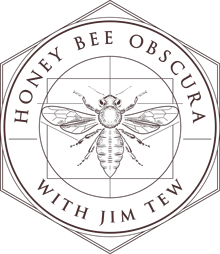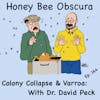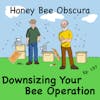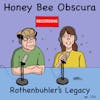Sampling Varroa Mites (166)

Join Jim Tew and David Peck in a critical conversation about Varroa mite management in beekeeping. This episode demystifies the process of counting mites, offering practical advice and insights into the importance of monitoring mite levels for the...
Join Jim Tew and David Peck in a critical conversation about Varroa mite management in beekeeping. This episode demystifies the process of counting mites, offering practical advice and insights into the importance of monitoring mite levels for the health of bee colonies. Discover various methods for assessing Varroa populations, from alcohol washes to powdered sugar shakes, and learn why accurate monitoring is essential for effective beekeeping. Whether you're a long-time beekeeper or just starting out, this discussion provides valuable strategies to help you maintain healthy honey bee colonies.
Featured Topics:
- Importance of Varroa mite monitoring
- Methods for counting mites
- Making informed management decisions
______________________
Thanks to Betterbee for sponsoring today's episode. Betterbee’s mission is to support every beekeeper with excellent customer service, continued education and quality equipment. From their colorful and informative catalog to their support of beekeeper educational activities, including this podcast series, Betterbee truly is Beekeepers Serving Beekeepers. See for yourself at www.betterbee.com
______________________
Honey Bee Obscura is brought to you by Growing Planet Media, LLC, the home of Beekeeping Today Podcast.
Music: Heart & Soul by Gyom, All We Know by Midway Music; Christmas Avenue by Immersive Music; original guitar music by Jeffrey Ott
Cartoons by: John Martin (Beezwax Comics)
Copyright © 2024 by Growing Planet Media, LLC

Episode 166 – Sampling Varroa Mites
Jim Tew: Honey Bee Obscura listeners, every one of us knows that we have Varroa mites in our bee colonies, but the devil is always how many mites do we have. When we do something, do you do something without checking to see how many mites you've got? Do you just go ahead and do it? What's the best protocol here? I've got the man who has all the answers. David, you here with us? Ready to talk about this? [laughs]
David Peck: All the answers, some of them right, most of them wrong.
Jim: Well, we'll sort them out. At least you've got answers. I know they have wrong answers sometimes and no answers at all.
David: It's better than the empty void of wondering.
Jim: I'm Jim Tew and I'm coming to you from Honey Bee Obscura, where we try to talk about something to do with beekeeping at least once a week.
David: I'm David Peck, the director of research and education at Betterbee. I am as always happy to join Jim and all of you and talk a little bit about bees.
Jim: I'd like to thank everybody. I'd like to thank the listeners and you for being here while we talk about exactly how do I count my mites.
Introduction: Welcome to Honey Bee Obscura, brought to you by Growing Planet Media, the producers of the Beekeeping Today Podcast. Join Jim Tew, your guide through the complexities, the beauty, the fun, and the challenges of managing honeybees. Jim hosts fun and interesting guests who take a deep dive into the intricate world of honeybees. Whether you're a seasoned beekeeper or just getting started, get ready for some plain talk that'll delve into all things honeybees.
Jim: That's the question, Dr. Peck. Exactly how do we count our mites? When do you count your mites and when do you decide that you're some trip mechanism? Where's a good place to go? Do you know to get answers? Give us your thoughts and comments here while we get this conversation going.
David: Well, let's start with the easier question there, which is how do you count your Varroa levels? How do you figure out how many mites you've got in your colonies? There's a bunch of different methods that you can use. There's a lot of methods that involve taking a sample of bees out of the hive and then separating the mites from the bees and counting how many mites there were in that sample. Those are generally going to be the methods that most of us use that most of us have recommended to us.
It's things like taking a half cup of bees, which we know is equivalent to about 300 of the bees, and then either doing an alcohol wash, killing the bees and the mites with rubbing alcohol, and then separating the two, or a soapy water wash. Does the same thing, kills the bees. All of that is based on an earlier test called the ether roll, which involved taking starter fluid and spraying it into a jar and then killing the bees and the mites that way and separating the two.
Then there are two more recently introduced methods or I guess one of them is older and one of them is newer, which are the powdered sugar shake or the CO2 sampling of Varroa mites. The advantages of those is that both of them at least purport to be non-lethal or less lethal for the bees because you're going to knock the bees out with carbon dioxide. You're going to cover the bees with powdered sugar and separate the mites that way, but then the bees will recover from that process.
Those are the methods that I think most of us lean upon. A great fallback. One of the older methods is just using a screened bottom board under your hive. Put a piece of screen into the frame of that bottom board, put a tray underneath it with something sticky on it like vegetable oil or a glue board, and then you figure out how many mites fall every day. Then you can get an estimate of how many mites there are in the hive from that.
Then I guess the last method to mention would be going into the brood itself, counting how many mites there are in brood, taking a cappings fork and popping a few drone brood out of their cells and counting how many mites there are on those drones. There's a lot of ways that you can look at mites, find mites in the hive, and try to get a sense of how many there are. I think the most important thing for a beekeeper making management decisions is you want to be accurate.
You want to have a real confident sense of, "Do I have a little mite population or a medium-sized one or a big one?" At the same time though, you don't want to do something that's so tedious and exhausting and miserable to do that you're not going to do the sampling at all. What I recommend is that you use whatever sampling method you're willing to use, and then I can steer you towards the ones that we know are a little bit more scientifically and statistically repeatable so that you're going to get the best number you can on your mites.
Jim: That's a good point. There's no reason to have a sophisticated process for determining the estimation-
David: -if you're not going to do it. [laughs]
Jim: -if it's miserable to do and you're not going to do it. [laughs]
David: Exactly.
Jim: Have you got a system that you like? Have you got a system that you think is efficient and simple enough?
David: Well, I'll tell you what I do with my own bees, which is that all of my hives through the summer have a screened bottom board under them. That means that I can go in there, I can spray some vegetable oil or pour some vegetable oil onto the sticky boards, and then I can go out and get a passive mite population count. I can just figure out how many mites fell under the entire hive over the course of a couple of days.
However, if I want to know what my mite infestation percentage is, that's not very useful. It just isn't accurate enough to do that. What I generally rely upon is that as sort of a backup or a low-investment monitoring tool. If I get worried about my mite population, then I'm going to go in and I'm going to use, typically, an alcohol wash on my bees. For years, I used the sugar shake method. For years, I would use powdered sugar to separate the mites and the bees.
I did that a lot during my research, but there's more work coming out now that's showing us that, yes, the bees survive when you cover them in powdered sugar and then beat them up and knock all the mites off of them. If you go back and you look for those bees one or two or three or four days later, you don't find too many of them around. They get so beat up in the process that, in some ways, it might be kinder to just kill them with the rubbing alcohol right at the get-go so we can figure out how many mites were riding around on them.
Jim: Well, that's sobering. I've never heard that. I always thought that you, in your own way, apologize to the bees for what you're about to do to them, but at least they had a chance to go forth and pollinate and do whatever. It's just not a normal procedure to be doused, I guess, in powdered sugar and all in your respiratory system.
David: It's an awful weird day that those bees go through. I do think it definitely shortens their lifespan. I've tried some of these carbon dioxide or CO2 sampling methods. I found the same thing, is that more often than not, I wound up with bees that just didn't make it through the process. I think instead of apologizing to the bees or explaining yourself to the bees that go through your sugar shake or your alcohol wash, it's reflecting upon the fact that a honeybee colony is a group of organisms living together who have agreed that they're willing to give their own lives for the good of the hive.
That's why they're willing to sting you even though they die when they sting. They've already done that calculus. They've done that math. They've said, "We are comfortable with a few of us individual workers dying because it's going to keep the colony as a whole healthy and alive. When we go in to do a mite monitoring test, even if it's going to kill 300 of those workers, I figure they've already made their peace with that. They've already accepted that 300 bees dying so that the beekeeper knows, "Hey, it's time to go grab the miticide right away." I figure that of all the organisms in the world, bees are probably going to be near the top of the list for willing to sacrifice themselves for that test.
Jim: You put a lot of thought in that, haven't you? You're putting a nice twist on the fact that you're killing bees to save them, but it is.
David: Well, I've killed an awful lot of bees, so I had to make my peace with it too, and that's how I've done it.
Jim: It is a very distasteful thing. I don't know how to word this to the new beekeepers out there, but there's just times in beekeeping where you really ask yourself, "Why did I ever get involved in this?" There's nothing any more rewarding and exhilarating than to clean up a winter kill. It's sticky and moldy and mildewy. You made some bad decisions and this colony died. Another instance is when you have to kill those 300 bees for the sake of acquiring the accurate mite count to know what it's going to take to save the rest of the colony.
David: That's it. As a scientist, it is important to me that I have accurate data, so I'm willing to do it. If you are a backyard beekeeper and you know that you just can't bring yourself to kill 300 bees, then get a screened bottom board. Use it. It's a worse sampling tool. If it's the only sampling tool that you're going to use, do that because you will always benefit by having a sense of how many mites there are in your hive. If your numbers aren't absolutely perfect, if it's a little high or a little low, then you're still going to profit by a bit of knowledge.
Jim: Well, let's take a break, hear from our sponsor and come back, and let's just pick up where we are going to start doing something and where to get those numbers that trigger us to do something.
Betterbee: Winter's chill won't last forever. It's time to think of spring. On warm days, take a break from hibernation and check to see if your bees are out and about, knock on wood or, better yet, a hive. No buzz? Can't hear the hum? Uh-oh, time to think ahead. You might need to replenish your colony. Fear not. Head to betterbee.com/bees and secure your package or new colony now. Don't be left out in the cold. Plan ahead. Because at Betterbee, we're making sure your spring bees are all abuzz.
Jim: David, I envision our listeners flying down the road at 55, 60 miles an hour listening to all these things we're saying here. There's no reason to give something that requires a whiteboard or some kind of number buddy. What numbers are we looking for? When do we panic and throw a switch somewhere?
David: Well, if you'd ask me 10 years ago, I would tell you what the published research said, and that was, when your mite levels get above 3% infestation, you should be nervous. Then more research came out and we said, "You know what? We really want to keep the mite level below 2% infestation." That means if I've got 300 bees and I do a sugar shake on them, I want to make sure that I've got fewer than six mites in my sample.
I know plenty of beekeepers who try to keep themselves below a 1% infestation, so your set point is going to vary and is going to depend on a lot of different factors. One thing that I do recommend to folks now is the Honey Bee Health Coalition, which is a great group, has put out a really handy table. Instead of being the local University of Missouri or University of Florida or Cornell or University of Maine professor going out and saying, "We did research and we found that you need to treat when your mites get above 2.5% or get above 3% or whatever it is," they've taken all of that research and put it together.
They've just said, "Look, in the spring or whatever you call spring, whenever your bee population is growing, this is the threshold that we recommend that you use to decide whether or not to treat your mites. Then in the summer, when your bees are sort of at their peak population and they're going around making honey, this is the number that we prefer you use," and so on and so forth.
Instead of saying, "In May, your mite levels have to be this. In August, your threshold should be that," they just say, "Look, look at what your bees are up to. Look at how they fit into the landscape and the seasons around you," and then, "Here are the numbers that research is telling us should guide your mite management." That's the table that I like to point folks to instead of just giving them a number. Then, typically, they twist my arm and they demand a number and I say, "Okay, fine, 2%." I think you'll profit more by reading through that table and understanding why those mite thresholds change across the course of the year.
Jim: We'll be sure to put that URL on the webpage for this issue if someone wants to follow up with the Honey Bee Health Coalition. Can I ask the question that must be lingering? If we're trying to keep our mite predation below 1%, that's really a small population of mites seemingly. That's getting pretty close to the bottom of the barrel. Is there ever a time, and I say this cautiously because I know some of the reasons why, when you just say, "Okay, I assume that I've got them. I'm going to forego all this checking and then killing and monitoring and just treat"?
David: Right, I assume I've got them. I assume they're above 1%. If I want to be below 1%, the way to get there is putting in a treatment.
Jim: Is that a bad thing? How big of a bad thing is that? Are you better off to do something than do nothing?
David: That's exactly right. It is a perfectly understandable thought. It's a thought that I've had myself. I say, "I know I'm going to go out here and treat, so why am I doing this monitoring?" What I'll say is this. The gold standard for managing your mites is that you check your mite levels because you need to figure out whether or not you need to do a treatment. If you are above the threshold, then you treat.
Remember, this is the gold standard. Then after that treatment is done, you go in and you check your mite levels again because you have to make sure that the treatment actually worked. If you go in and you check and you say, "Geez, I've got 3% mites. Better treat," and you put the treatment in, we don't get to pat ourselves on the back and assume it worked. We've got to go back in and do the test and say, "Uh-oh. Now, it's only 2%," but that's still too high. Now, I've got to do something else.
If you have the time and the resources and you really want to do best by your bees, I cannot recommend anything more strongly than monitoring, treating, and then doing follow-up monitoring to make sure the treatment worked. We're real people and we're real beekeepers. Summers get real busy. It's sometimes hard to find all that time. If you have to drop one of those, I would say probably drop the follow-up treatment or the follow-up monitoring, the follow-up mite check, because we know we only treat when we're above the threshold.
Then we assume that we're going to be doing some other check later on in the year. That's going to wind up being our follow-up just to confirm that things are going as we expected in the hive. If you don't have time to do either, if you say, "Hey, I've only got 20 minutes to pop out to the apiary," I can either do some mite checks or I can just grab all of these formic acid pads or these ApiLife Var tablets or whatever miticide you prefer and throw them into the hives.
Yes, I'd rather that you treat and keep your mites under control than that you don't do anything at all. If you have to drop two of those three steps I said, monitor, treat, and monitor again, I'd drop both of the monitoring and I'd just go ahead and do the treatment. If you've ever tried that, what you'll find is you can get yourself in real big trouble. You can get your bees in real big trouble.
We have a schedule here at Betterbee where we know roughly when we need to go out and put this treatment on the hives or that treatment on the hives every year, but we still do monitoring. We do it because, two years ago, we were confident that we absolutely did not have to do anything until the 4th of July because we never had to ever do any treatments until the 4th of July.
We went out and we did some monitoring in June and we said, "Geez, the mite levels are really dangerous." Something went wrong. We've got to go in and treat right away. We changed our plans as a result. I think that there's great benefit and great power in being a beekeeper who takes the time to check their mite levels and uses that as part of their management strategy.
I am sympathetic to the beekeeper that says, "Look, I just don't have the time," or "I don't have the strength," or "I don't have the resolve to go and murder 300 of my little bees. I'm just going to do my treatments." I think that can work, but it can also fail. If it fails, when you're sitting and looking at all of your notes and reflecting upon why your bees died from mites last year, you don't have a lot to go on for where you can improve because you just don't have the data on when your mites were low and when they were high.
Jim: It's just like maintaining a calendar for a night burn pollen flow. You have an idea of when those are starting.
David: Yes, and you don't have to. You can just slap your supers on May 1st and pull your supers off in September and do your harvest and ignore when the flows were happening. You'll be a much better beekeeper if you go through the trouble of just paying a little bit more attention and trying to figure out what's going on with your bees on a week-to-week basis.
Jim: Give me a second to make this comment and then to get back to why I'm making the comment. Years ago, I gave a talk at a meeting. I was discussing how to use some of the new webpages 25 years ago. After it was over, a beekeeper came up and told me emphatically that he came to this meeting to learn about bees, not to learn about computers. Even though I was trying to use my lecture as a discussion on how he could use computers and webpages to further his beekeeping, he didn't see it that way.
With that thought in mind, I'm anguishing while I'm listening to you talk because I want to keep bees. I don't want to work with these mites, but I keep being funneled into doing this significant amount of extra work, testing, killing, counting, record-keeping, and all of that is for Varroa. None of that is to meet my passion for seeing a great queen doing a great job, full brood patterns, nice flow coming in, white cappings. To get to that now, I've got this extra level that all modern beekeepers have to go through.
They've got to control those mites. On one hand, you're exactly right. Actually, on every hand, David, you've been exactly right. You've got to do this numbers. You've got to check the count. As best you can, go do it. I'm 75 and a half. I don't have the energy I used to have. I'm thinking, "Well, you've got to take off three supers and get dig down to it. There's just the reality of existence sometimes that the best you can do is just not going to be grade A anymore.
I don't know what I'm saying here other than the fact that this is a sobering discussion that we're having. Because if you do nothing, your bees are going to go down. I know, David. There's a lot of people out there that say they don't use chemicals and somehow the bees survive. Mine don't. Mine do not survive. If I let mine go, I am going to go out of the bee business. I am not in a location where I can do that. I'm one of the ones who has to do something.
David: A lot of those treatment-free beekeepers you talk to, if you do talk to them, the ones that are really having success, they're not putting any chemical miticides in, but they are doing bee management that is also helping the bees cope with the Varroa. That's often a really important part of it. I'm very sympathetic with the complaint of your fellow who came up after your lecture at that bee club meeting that says, "I came here to talk about bees, not all this dumb, boring, miserable stuff."
That's a problem that I have as well. Folks want me to come talk to their club or their meeting and talk about Varroa. They'll say, "Oh, well, will you do the keynote?" I said, "I'll do the Varroa lecture and I'll do the keynote, but I'm not going to do the Varroa lecture as the keynote because I don't want to stand up here and say, 'Hello, everybody. Thank you for driving halfway across your state. I'm going to tell you a bunch of terrible news.'"
I say, "I'm going to teach you about waggle dances in the keynote. We're going to talk about beautiful queen behaviors in the keynote. Then you can come into this room and I'm going to talk to you all the hot gossip about Varroa management," because it is depressing. At the same time, the person who says, "I got into this to keep bees and not manage mites," is sort of like the person who says, "I bought this sports car because I like driving it around. Why do I keep having to go to work so that I've got money to put gas in the thing?"
You've got to go do the maintenance. At the same time, the point we already touched on is, because of your age, because of your strength, because of your schedule in the summer, whatever it is, if you don't think you've got the time to go dig through those colonies and pull out brood and shake them into a container and get 300 of them and do the alcohol wash and note down all of your mite levels, well, that's fine.
You're a good candidate for a screened bottom board or a capping scratcher that you can go scrape open some brood comb and at least count how many mites there are in the drones. What my recommendation is, in a perfect world, I'm going to tell somebody that they should be doing monthly mite checks on their bees and that they should treat whenever they hit a threshold. If they can't do that, I won't miss a beat before I tell them they should be doing checks every two months.
If they won't do that, I'll tell them they should do checks every three months. Because if I can get somebody to do a little bit more monitoring, they're going to wind up with a better understanding of what's happening in the hive. Same is true, folks call me all the time. They say, "David, you're Mr. Varroa, so what is it that I should be doing to figure out how many mites I've got in my apiary? Before you answer, I've got 10 apiaries and I've got 40 colonies in each one. Does that mean that I need to be doing 400 mite checks once a month?" I say, "Well, no, that's probably not right." They say, "Well, can I just sample two or three colonies and is that good enough?"
I say, "Well, no, that's probably not good enough either." They say, "Well, what's the right number of colonies for me to sample?" I say, "How much time do you have and how much good weather do you have to go out and do it?" You're going to get better information if you go out and you check four colonies in every apiary. You're going to get even better information if you check eight colonies in every apiary. It's up to you, the beekeeper, to decide how good you want your data to be. I promise you. I have never met anybody who said to me, "I got a really clear picture of what my Varroa mite levels were in my bees and I regret it."
Jim: Oh, that's interesting.
David: Because the clearer that picture is, the easier it is for them to say, "Hey, you know what? If my mite levels are low, I don't need to waste my money and I don't need to put the bees through the stress of putting that miticide on," or they go and they do a check and they say, "Geez, the level was really high in this one. Why don't I check a few more? Uh-oh, it's really high in all of them. Now, I know I definitely need to do my interventions right away." You profit a lot and your bees profit a lot by investing that little bit of time. Yes, it's not fun. It's not fun to kill bees. It's not fun to look or even think about parasites. By doing that, it keeps the bees alive. Living bees are the ones that make honey and charm us as they fly in and out of the hive. We've got to give them that much.
Jim: I was going to go back to a point you made early in this discussion that, yes, it is distasteful to sacrifice those 300 bees, but they were probably already on the short end of their life as it was. I don't want to rush them in any way and I feel terrible looking at them, but they serve a good purpose if you do the count correctly and draw the correct conclusions that keep the remainder of the core colony healthy and productive.
David: That's it. A worker bee's lifespan in the summer might be six weeks if she's lucky. If I go in and I have to kill her at three weeks, then, sure, she's missed out on some fun experiences she might have had, but what is the life of a summer worker bee? Well, it's basically just working herself to death, collecting pollen or water or honey or propolis. If we go in and we cut their lives a little bit short so that we can keep all of their sisters and their mother and their nieces and whoever's alive in that colony, it winds up, I think, on balance. It's a sacrifice that I'm willing to make as a beekeeper. I bet those bees in some way are willing to make for the good of their family.
Jim: Well, I've heard you say this. I've heard you say monitor and have a good idea, the best idea you can get of what your mite levels are, and then do something. You decide what to do. Monitor and then do something.
David: That's it.
Jim: All right. Did I read you correctly?
David: [chuckles] That's it. If you choose to do nothing, at least you're doing nothing with the benefit of knowledge and not doing nothing in ignorance.
Jim: Okay. [chuckles] All right, I always enjoy talking to you, sir. If you don't mind, we'll do some other topics some other time soon.
David: It's always a pleasure. Thank you for having me.
Jim: Thank you for being here, sir.
[music]
New to Honey Bee Obscura Podcast?
Here are some great episodes to start with. Or, check out episodes by topic.







 Join Jim Tew and David Peck in a critical conversation about Varroa mite management in beekeeping. This episode demystifies the process of counting mites, offering practical advice and insights into the importance of monitoring mite levels for the health of bee colonies. Discover various methods for assessing Varroa populations, from alcohol washes to powdered sugar shakes, and learn why accurate monitoring is essential for effective beekeeping. Whether you're a long-time beekeeper or just starting out, this discussion provides valuable strategies to help you maintain healthy honey bee colonies.
Join Jim Tew and David Peck in a critical conversation about Varroa mite management in beekeeping. This episode demystifies the process of counting mites, offering practical advice and insights into the importance of monitoring mite levels for the health of bee colonies. Discover various methods for assessing Varroa populations, from alcohol washes to powdered sugar shakes, and learn why accurate monitoring is essential for effective beekeeping. Whether you're a long-time beekeeper or just starting out, this discussion provides valuable strategies to help you maintain healthy honey bee colonies.






